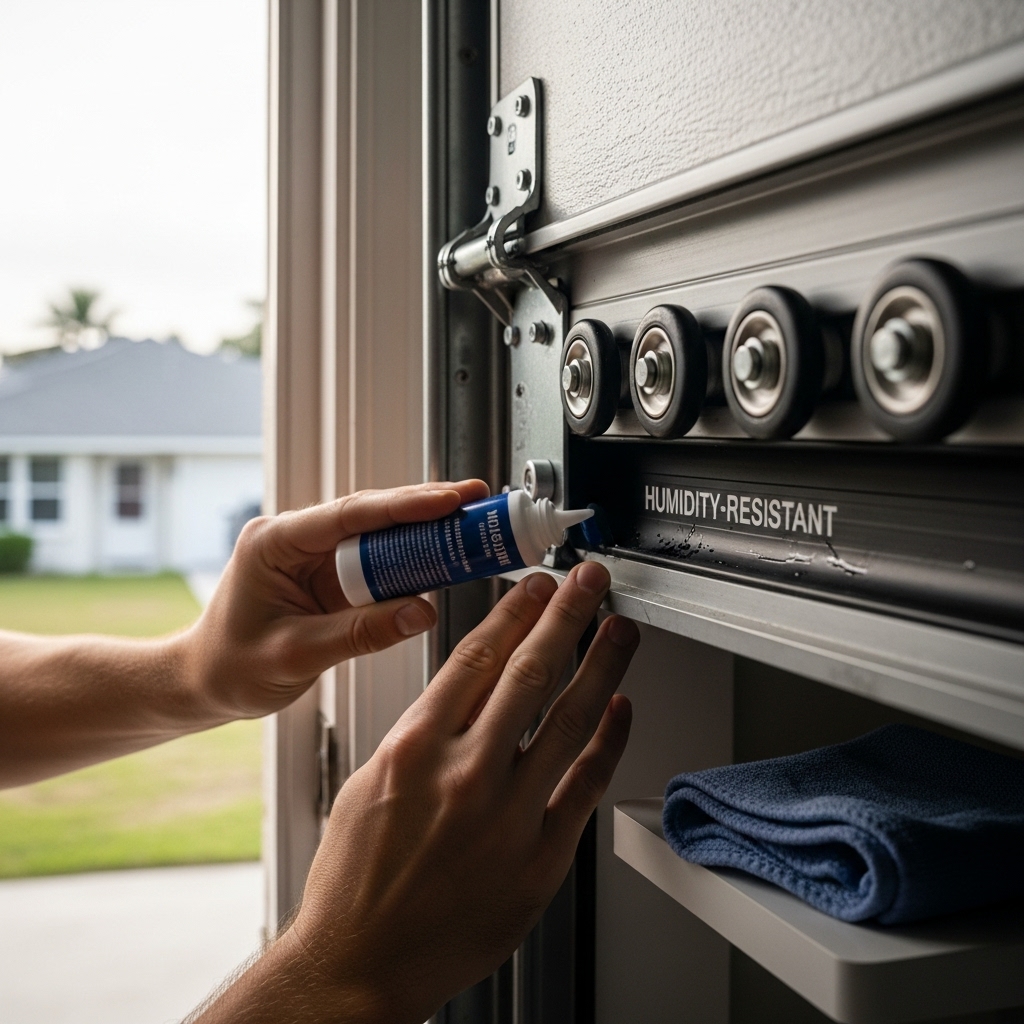Introduction: Keep Your New Florida Garage Door Performing Like New
Florida weather can be tough on garage doors. Sun, salt, humidity, and seasonal storms combine to test every hinge, seal, and fastener. If you’ve recently upgraded—or plan to—proper maintenance will protect your investment, extend lifespan, and keep your home ready for wind events. This guide provides a Florida-specific care routine, from monthly checkups to pre-storm preparations, so your door stays quiet, smooth, and secure. If your door shows damage or you want a pro to evaluate its condition, consider scheduling expert garage door replacement or service to restore full performance.
Understand Florida’s Challenges
Three forces dominate Florida garage door maintenance: corrosion from salt air, moisture-driven deterioration, and wind pressure during storms. Coastal neighborhoods experience accelerated rust on steel components and discoloration on finishes. Humidity promotes condensation that can creep into hinges and bearings. Hurricane-season winds test reinforcement struts, tracks, and anchoring. Knowing these stressors helps you prioritize the right products and routines.
Monthly Visual Inspection
Once a month, perform a quick but thorough inspection. Watch the door through a full open/close cycle. Listen for scraping or grinding; these sounds can indicate misalignment or a roller bearing beginning to fail. Look over hinges, brackets, struts, and fasteners for rust or looseness. Check that photoelectric sensors are aligned and clear of cobwebs, which are common in humid garages. Finally, examine seals along the sides, top, and bottom for cracking, shrinkage, or gaps that could let wind-blown rain or pests inside.
Quarterly Cleaning and Lubrication
Every three months—more often near the coast—wash the door’s exterior with mild soap and water to remove salt residue and grime. Rinse thoroughly and dry with a clean towel to prevent water spots and streaking. Wipe down metal components inside the garage to remove dust and moisture film. Lubricate hinges, bearings, and torsion springs with a garage-rated, non-gumming lubricant designed for humid conditions. Avoid heavy greases that trap grit; instead, use a light, penetrating formula and wipe excess to keep surfaces clean.
Protect Against Corrosion
Corrosion prevention in Florida requires a proactive mindset. Inspect for early rust at hinge knuckles, spring coils, and the bottom of tracks where moisture collects. Spot-treat tiny rust blemishes with a fine abrasive pad and touch-up paint compatible with your door’s finish. Replace severely corroded fasteners with stainless or hot-dipped galvanized versions. In coastal zones, consider scheduling a biannual rinse of all exterior metal and applying a protective wax or sealant approved by your door manufacturer.
Seal Integrity and Water Management
Wind-driven rain can infiltrate even small gaps. Examine the bottom seal for compression set or cracking; replace it if the slab has worn a groove or if daylight shows through. Side and top weatherstripping should lightly contact the door without causing binding. Refresh sealant where exterior trim meets masonry to block water paths. If your slab slopes or is uneven, a threshold system can improve sealing under the door. Keep nearby gutters, downspouts, and driveway drains clear to prevent pooling water from pushing under the seal during storms.
Track Alignment and Roller Care
Tracks should be plumb and securely fastened to solid structure. Look for loose anchors, especially in masonry where vibration can slowly widen holes. If tracks are out of alignment, rollers may bind or jump. Rollers with sealed bearings require less maintenance; if yours have exposed bearings, apply a small amount of appropriate lubricant and wipe away excess. Replace cracked or worn nylon rollers promptly to reduce noise and stress on hinges.
Spring System Attention
Torsion springs in humid environments can develop surface rust that shortens lifespan. A light application of the correct lubricant helps protect coils, but do not over-apply. Listen for a boing or ping sound during operation; it can indicate a spring losing tension or a coil snagging. Never attempt major spring work without proper tools and training. Instead, schedule a professional safety check if you suspect imbalance—especially before storm season.
Opener Reliability in Storm Season
Power outages and surges are common during tropical weather. Ensure your opener has a surge protector and consider a battery backup so you can operate the door without grid power. Test the manual release cord to ensure you can disengage the opener quickly if needed. Verify that force and travel limits are set correctly; a door that slams or fails to reverse on contact needs adjustment to protect people and pets.
Pre-Storm Preparation Checklist
- Inspect reinforcement struts and fasteners for tightness.
- Confirm locks or manual slide bolts function correctly.
- Remove loose items from the garage that could become projectiles.
- Ensure your vehicle’s remote and backup key are accessible in case of outage.
- Photograph your door and hardware for insurance documentation, especially in coastal zones.
After-Storm Inspection
After high winds or heavy rain, visually inspect the door before operating the opener. Look for panel dents, misaligned tracks, or pulled fasteners. Check seals for tears and retighten any loose hardware. If the door is stiff, noisy, or scraping, stop and schedule service to prevent further damage. Salt spray often accumulates during storms; rinse and dry the exterior as soon as practical.
Energy and Comfort Considerations
Though garages in Florida are often unconditioned, insulated doors moderate temperature swings and limit condensation that encourages corrosion. Keep the garage well-ventilated; exhaust fans or passive vents reduce humidity. If your garage houses a laundry area or water heater, maintaining good seals helps control moisture and keep pests out.
When to Call a Pro
Maintenance tasks like lubrication, cleaning, and seal replacement are homeowner-friendly. However, if you notice severe corrosion on springs or cables, repeated sensor faults, significant slab gaps, or structural movement around the opening, it’s time for expert evaluation. For persistent problems or evidence of storm damage, a trained technician can recommend repairs—or a full garage door replacement if the system is beyond economical repair—matched to Florida’s code and climate.
FAQ: Florida Garage Door Maintenance
Q: How often should I lubricate my garage door in Florida?
A: Every 2–3 months is a good routine, with extra attention after storms or if you live near the coast where salt exposure is higher.
Q: What’s the best way to prevent rust?
A: Regular rinsing, prompt touch-up of paint nicks, stainless or galvanized fasteners, and light lubricant on moving parts significantly slow corrosion.
Q: How do I know if the door is out of balance?
A: Disconnect the opener and lift the door halfway; it should hold position. If it drops or rises, the springs may need adjustment—call a pro for safety.
Q: My bottom seal keeps wearing out. What can I do?
A: Check for slab irregularities and consider a threshold system. Choose a high-quality, UV-resistant seal designed for your door model.
Q: Should I wash the door with a pressure washer?
A: Avoid high-pressure settings close to seals and edges; use mild soap, water, and a soft brush or cloth to protect finishes and weatherstripping.
Keep Your Florida Garage Door at Its Best
With a consistent care routine tuned to Florida’s climate, your garage door will run smoothly, look great, and stand ready for storm season. If you want a professional assessment, adjustments, or a new system engineered for local conditions, schedule trusted garage door replacement and enjoy a resilient, low-maintenance upgrade that protects your home year-round.

